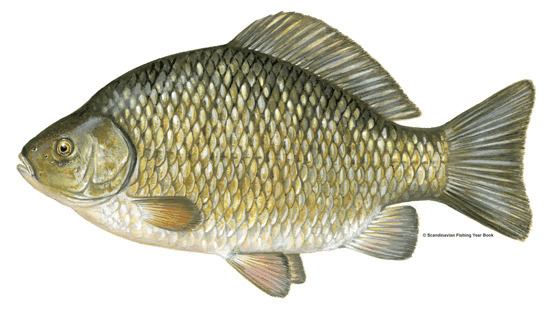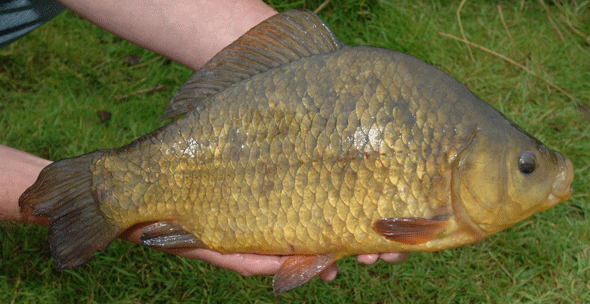Higher classification Carassius | Phylum Chordata Scientific name Carassius carassius Rank Species | |
 | ||
Similar Tench, Common roach, Common carp, Common bream, Common rudd | ||
Float fishing for crucian carp tafishing
The crucian carp (Carassius carassius) is a medium-sized member of the common carp family Cyprinidae. It occurs widely in northern European regions.
Contents
- Float fishing for crucian carp tafishing
- Crucian carp tackle and tactics
- Distribution
- Description and taxonomy
- Physiology
- Sports fishing
- Relation to goldfish
- Use
- References

Crucian carp tackle and tactics
Distribution

Carassius carassius is a widely distributed European species, its range spanning from England to Russia; it is found as far north as the Arctic Circle in the Scandinavian countries, and as far south as central France and the region of the Black Sea. Its habitat includes lakes, ponds, and slow-moving rivers. It has been established that the fish is native to England and not introduced.
Description and taxonomy

The crucian is a medium-sized cyprinid, typically 15 cm in body length, and rarely exceeds in weight over 1.5 kilograms (3.3 pounds). But a maximum total length of 64.0 cm is reported for a male, and the heaviest published weighed 3 kilograms.

They are broadly described as having a body of "golden-green shining color", but a more precise source states that young fish are golden-bronze but darken with maturity, until they gain a dark green back, deep bronze upper flanks, and gold on the lower flanks and belly, and reddish or orange fins, although other colour variations exist. One distinguishing characteristic is a convexly rounded fin, as opposed to goldfish (or C. gibelio) hybrids which have concave fins.

The variation in shape of a crucian carp can be very high. When cohabiting waters where predatory such as pike or perch fish are present, there occurs an induced change in the morphology of the population, from a sleeker to a deeper bodied form, into almost perfect disc shape with well-rounded fins, making it difficult for predators to swallow the crucian carp.
The crucian carp is also the type species for the genus, which has led to confusion in the taxonomy of species native to East Asia.
There are reports of hybridisation between the crucian and domestic or feral goldfish, which has been verified by production of viable hybrids in laboratory conditions. Although the hybrids thus produced were sterile or nearly so, genetic contamination of the native population has been raised as a concern; even if the hybrids cannot continue to propagate, the F1 hybrids exhibit hybrid vigour or heterosis, being much more adept at finding food and evading predators than either of their parents, which has been proposed to constitute a possible threat to the native crucian carp population.
Physiology
Carassius species exhibit some remarkable physiological adaptations to their environment. For example, in entirely anoxic conditions during winter Crassius crassius can survive for considerable periods by anaerobic respiration, with ethanol as the major metabolic end product; a facility that is highly unusual among vertebrates. During summer the fish also may survive anaerobic conditions by this metabolic expedient, though only to a far more limited extent; the winter phenotype can sustain fermentation as a substitute for respiration for several weeks on end. Experimentally the fish have been maintained under anoxic conditions for 140 days. Anoxia can be tolerated longest in the coldest water, even down to 0 °C, because colder conditions lower the metabolic rate. Alcohol production occurs mainly in the muscle tissues, but also in the liver, where the process is thought to have originated. Similarly goldfish can produce alcohol in muscle tissues, but to a much more limited extent.
Experimentally it has been demonstrated that the metabolic process involves the production of pyruvate from lactate, followed by decarboxylation to acetaldehyde which then is hydrogenated to ethanol as the major metabolic end product. In turn the fish largely excretes the ethanol into the water rather than accumulating it to toxic levels in the tissues. Excretion of lactate in significant quantities is not a common nor a desirable metabolic facility, but the excretion of ethanol presents no serious metabolic challenges. This metabolic expedient avoids the fatal accumulation of acid end-products of anaerobic glycolysis.
Sports fishing
In Britain, leisurely or competitive catching of this fish by rod and tackle belong in the coarse fishing category. The British rod-caught record for largest crucian is four pounds, nine ounces, (2.085 kg) landed by Martin Bowler in 2003, tied by Joshua Blavins in 2011. There have been various bids for a breakage of this record since, but they were rejected as not "true" crucians" but rather, e.g. a "brown goldfish variant" (i.e., hybrid born between the non-native goldfish or gibelo species and the British crucian). In the Netherlands, a typical crucian specimen of 54 cm, weighing 3 kg has been caught and photographed.
Relation to goldfish
Many sources state that the goldfish (Carassius auratus auratus) is a cultivated breed of crucian carp taken from the wild. Since "crucian carp" is the name of the genus this is not strictly wrong, but certainly ambiguous and misleading. Genetic research has shown that the goldfish actually derives from the Prussian carp Carassius gibelio.
Aside from confusion in nomenclature, there is the practical issue of distinguishing true crucian carp from goldfish hybrids in, e.g., competitive coarse fishing. The following is based on a similar table of guidelines constructed by the Farnham Angling Society:
Use
These carp are also occasionally kept as freshwater aquarium fish, as well as in water gardens, although they are not commonly available commercially, mainly because they are not in particularly high demand due to the presence of more colourful fish such as the koi or orfe.
It has been suggested that this is a heavily farmed fish worldwide; FAO's newest statistics from 2008 (pub. 2011) shows total production C. Crassius at 1,957,337 tonnes, worth US$2,135,857,000, ranked 9th in worldwide in aquaculture, including marine fish and crustaceans, however this statistics treats the Asian C. gibelio carp as a subspecies of the European crucian carp, and it is evident that the greater bulk of this number is from the Asian fish farmed in China.
In terms of freshwater catches of C. Crassius (read Carassius spp.), FAO's 2006 statistics show 5.53 thousand tons harvested, which ranked 13th worldwide among freshwater fishes caught. The breakdown was Kazakhstan 2.2, Japan 1.12, Serbia 0.84, Moldova 0.19, Uzbekistan 0.19, Poland 0.13. In these figures, the tonnage from European countries may represent C. Crassius in some part.
In Poland, crucian (Polish: karaś) is considered the best-tasting pan fish, and traditionally served with sour cream (karasie w śmietanie). King's Carp (previously Galician Carp as in Galicia in the Austro-Hungarian Empire) – the breed of Carp created in Poland, in Kaniow, the "hump" is bigger than average and the scales are larger than average. Carp is included amongst the holiday foods in Poland. The tradition might have Jewish origins.
In Russia, this particular species is called Russian: Золотой карась meaning "golden crucian", and is one of the fish used in a borscht recipe called borshch c karasej (Russian: Борщ с карасе́й)or borshch c karasyami Russian: Борщ с карася́ми).
